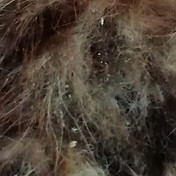


Flystrike - Myiasis
Flystrike can happen to any rabbit regardless of whether they live indoor or outdoors. It is a painful, life threatening condition.
Bluebottles and greenbottles, known as blowflies, lay their eggs on dead bodies, wounds and on fur covered in faeces or wet cecotropes. Flies are attracted to damp smelly conditions. It can develop quickly as the eggs only take a few hours to hatch. The maggots that hatch from those eggs burrow under the skin and eat the flesh they are laid on - this is nature. It causes severe damage and they release toxins, which may produce shock, severe illness and ultimately death. It is an absolutely horrific condition and a terrible way for your rabbit to die.


The white specs you can see on this zoomed in image are fly eggs.
You can help protect your rabbits by keeping the area that they use and their bottom as clean as possible to deter flies; particularly in summer when they are more prolific. Overweight rabbits are less able to keep themselves clean so keep an eye on their weight and act accordingly. Other conditions which make them more susceptible to flystrike is being arthritic, longhaired, having poor balance, a large dewlap, dental disease, open wounds and abscesses.
Make sure your rabbit gets a good diet (preventing loose stools) and doesn’t have mobility problems that prevent it from eating cecotropes directly from its bottom, if the bottom stays clean the risk of Flystrike is greatly reduced.
Symptoms of flystrike include:
Visible maggots / eggs in the fur / under the skin
Patches of wet fur, fur loss, sore looking skin
Low energy
Eating less
Collapse
Bad smell
You can reduce the likelihood of fly strike by using fly screens on their accommodation.
There are a number of products you can apply to your rabbits rear end to prevent fly eggs from hatching, ask your vet (we recommend F10 wound spray with insecticide; check the bottle for the application procedure. We don't advise that you handle your rabbits to check this area everyday as this could be quite stressful for them, instead try and check as they hop away from you or gently lift their tail if they will allow you to. Avoid diarrhoea in your rabbit by making gradual changes to their diet over at least one week, especially with spring/early summer grass and leafy greens. Try a hay only diet until their stools return to normal (consult vets if this accompanies reduced or no appetite).
Just be aware flies can lay their eggs on any part of a rabbit. Check underneath and around the bottom for faecal soiling, urine scalding, sore places and matted fur and to see if there are any sign of fly eggs or maggots; if you find any eggs or maggots on your rabbit, even if it is just one maggot you see, you will need to get it to the vet immediately; don’t attempt to wash it or clean it in anyway just get them to the veterinary clinic.